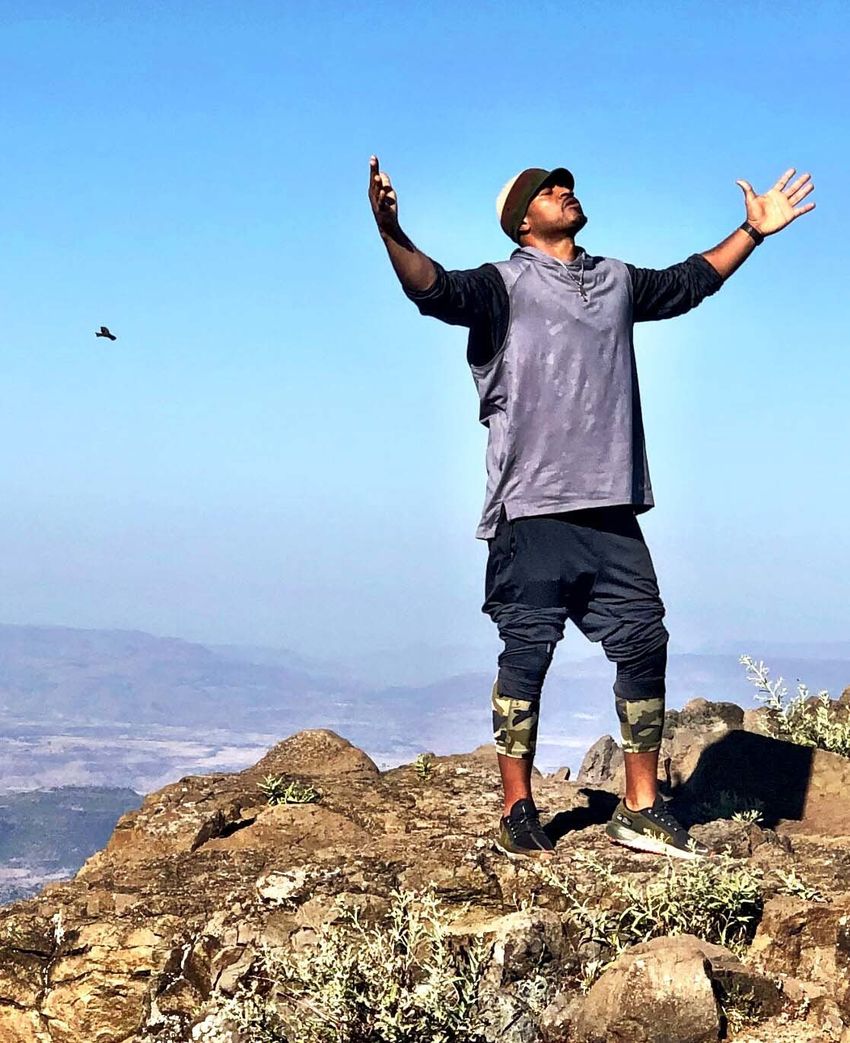Experienced by Kimatni D. Rawlins
Selam, and welcome to “the origin,” the African nation that has never been colonized by Europeans. Lookup "The Battle of Adwa" where King Menelik II defeated the Italians in an epic sequence of historical consequence. Finally, after years of research, readings, teachings, and listening to roots reggae rhythms epitomizing The Promised Land, I took the requisite steps needed for a transformative Ethiopian experience as part of my 6th Annual Nomadic Journey in Addis Ababa and Lalibela.
I ventured to Ethiopia for its strength, Abyssinian culture, veggie injera meals, traditional Eskista shoulder dance up close, and to breathe with deep spirit from the highlands of Lalibela. I began the excursion upon landing into Addis Ababa, the capital and largest city of Ethiopia. I enjoyed many of the historical sites, including the National Museum of Ethiopia, Ethiopian National Theatre, Ethnological Museum, the Red Terror Martyr's Museum, and Menelik Palace in the Entoto Hills. The Historic Kidist Selassie Cathedral is the highest-ranking Ethiopian Orthodox Tewahedo Church in the city. Sarcastically, I was also looking for freedom fighting singer Teddy Afro, the Bob Marley of Ethiopia. Listen to any of his classics, and you will become an instant devotee. Trust me!
Of course, I maintained my daily exercise routine by running with local athletes at Addis Ababa Stadium and rewarded myself afterward with amazing veggie injera dishes (made from teff) with lentils and cabbage at 2000 Habesha Cultural Restaurant. My distant brothers and sisters were seriously kicking it during the culinary outing. If the Ethiopian Eskista dance were adopted globally, the entire world would be fit! In regards to food, keep in mind that the staple for mostly every indigenous culture is a legume (bean) or grain. The natives include fruits and veggies as a vital part of daily life. In Lalibela, for example, most of the people of the country are super healthy farmers who plant wheat, barley, chickpeas, lentils, and teff. Locals also tend to walk more and use their hands for physical activities, so they stay fit naturally. Rarely did I see any obesity while exploring Ethiopia. Continue to strive towards healthier aspirations for life extension.
Next up was an immersing trek in the purifying grounds of Lalibela, rightfully christened after Zagwe King Gebre Mesqel Lalibela. This village town, located in the highlands NE of Addis Ababa, is one of the holiest places on earth as Orthodox Christians journey here consistently to give thanks and praise at the 11 medieval, monolithic, rock-hewn churches with the Church of Saint George representing as the most renowned and the trademark of Lalibela. Though, Bet Medhane Alem is the largest of them all. It's breathtaking seeing these wonders while wondering how they were carved using just chisels, axes, and other hand tools 900 years ago. Walking from church to church was excellent on the body as well.
The days that followed, I went hiking with a local guide to witness the habits of the countrymen and women. My first exploration was a trek up Ashene Mountain to ascend to a higher, planar dimension where the birds fly free. It is extraordinary that an entire community of families, animals, and farmers live atop Lalibela's third highest mountain in mostly traditional Tukel houses and survive by cultivating the land. Impressive were the young kids and elderly whisking by me with ease since this is their usual routine, and in sandals at that! Afterward, I made sure to eat at Benabeba while gazing at the magnificent sun setting over the landscape. Lalibela, I shall return soon come.
Since I love roots rock reggae, another reason I ventured to Ethiopia was to study the correlation between the Jamaican Rastas and Haile Selassie I, who was the Emperor of Ethiopia until 1974. You will hear verses of the King of Kings, The Promised Land, and The Chapel recited in almost every cultured reggae singer or group’s music since the early 70s. Many like Bob Marley have even used the words of Haile’s speeches in their lyrics.
One of my interviews was with an Ethiopian Ras who had a unique perspective on the Power of the Trinity (Selassie, Garvey, and Melchizedek) as he is a true believer. Ebenezer took me to notable sites, including the Historic Kidist Selassie Cathedral, where the 20th century Emperor’s throne and body resides. The energy was indeed intense. But depending on which Ethiopian local you speak with, you will receive a diverging viewpoint on the late Emperor’s reign. Selassie ruled over four decades until dethroned for the 1973 famine, and two years later was smothered in bed at the age of 83. Half the people revered him, and the other half despised his antics such as senseless killings of Ethiopians for minor reasons.
As the story goes, Selassie visited Jamaica during a drought, and upon arrival, it rained which sent Jamaica in a state of jubilation. Marcus Garvey also told fellow Jamaicans to look towards the east for the next Biblical messiah. Coincidence? Not sure, but Selassie, known as Ras Tafari Makonnen before his coronation, became their Jah. He also granted land to the Rastas in Sheshamane (The Promised Land) which is a 4-hour drive from Addis. Either or, Selassie was a compelling figure worldwide and used his international influence to build Addis Ababa University and other technological infrastructures to help his country prosper. My research continues, and there seems to be no ending to understanding from both perspectives.
Yes, nirvana was strengthened during my African pilgrimage. Ethiopia is an absolute must-visit for anyone seeking higher consciousness pertaining to man's destiny. After two weeks of exploring the indigenous lands, I returned to the U.S. more enlightened than any other period. Life is for experiencing, so follow your heart people.


















